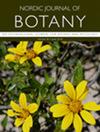Predicting the effect of climate change on the geographic range of the Mediterranean relict tree Liquidambar orientalis Mill
IF 1
4区 生物学
Q3 PLANT SCIENCES
引用次数: 0
Abstract
Climate change is anticipated to pose a significant danger to the habitats and spatial distribution of species in the Mediterranean region throughout the present century. The primary objective of this study was to predict the future geographic range of预测气候变化对地中海孑遗树种 "Liquidambar orientalis Mill "地理分布的影响
预计气候变化将在本世纪对地中海地区物种的栖息地和空间分布构成重大威胁。本研究的主要目的是预测在不同的气候变化情景下,Liquidambar orientalis(俗称东方甘李)未来的地理分布范围。该物种是一种起源于安纳托利亚西南部地区和希腊罗多斯岛的地中海河岸植物。为了深入了解气候变化对未来东方桉树分布范围的潜在影响,我使用了基于共同社会经济路径(SSP1-2.6 和 SSP5-8.5,2035、2055 和 2070 年)的物种分布模型集合建模方法。这些模型表明,最潮湿月份的降水量对东方桉树的出现起着至关重要的作用。未来预测表明,由于气候变暖和降水量减少,东方甘李的原生分布范围将大幅缩小。此前,由于人类活动的影响,东方桉树的数量已经减少。因此,面对人类活动造成的后果和气候变化的持续影响,加强东方甘李物种保护工作的紧迫性势在必行。
本文章由计算机程序翻译,如有差异,请以英文原文为准。
求助全文
约1分钟内获得全文
求助全文
来源期刊

Nordic Journal of Botany
生物-植物科学
CiteScore
1.90
自引率
11.10%
发文量
100
审稿时长
2 months
期刊介绍:
Nordic Journal of Botany publishes original contributions on all aspects of the taxonomy, evolution, conservation, ecology and biogeography of plants (including algae and bryophytes) and fungi.
 求助内容:
求助内容: 应助结果提醒方式:
应助结果提醒方式:


